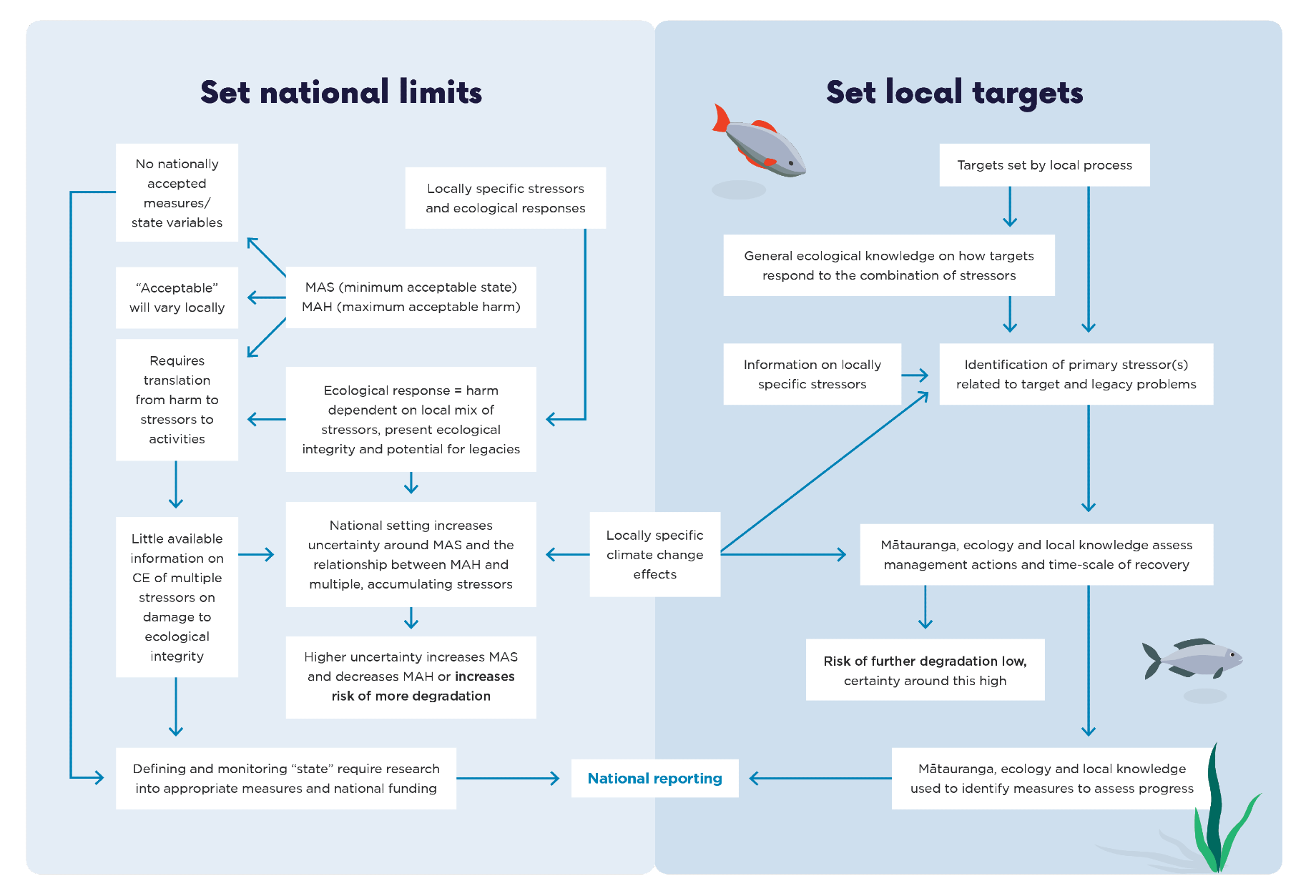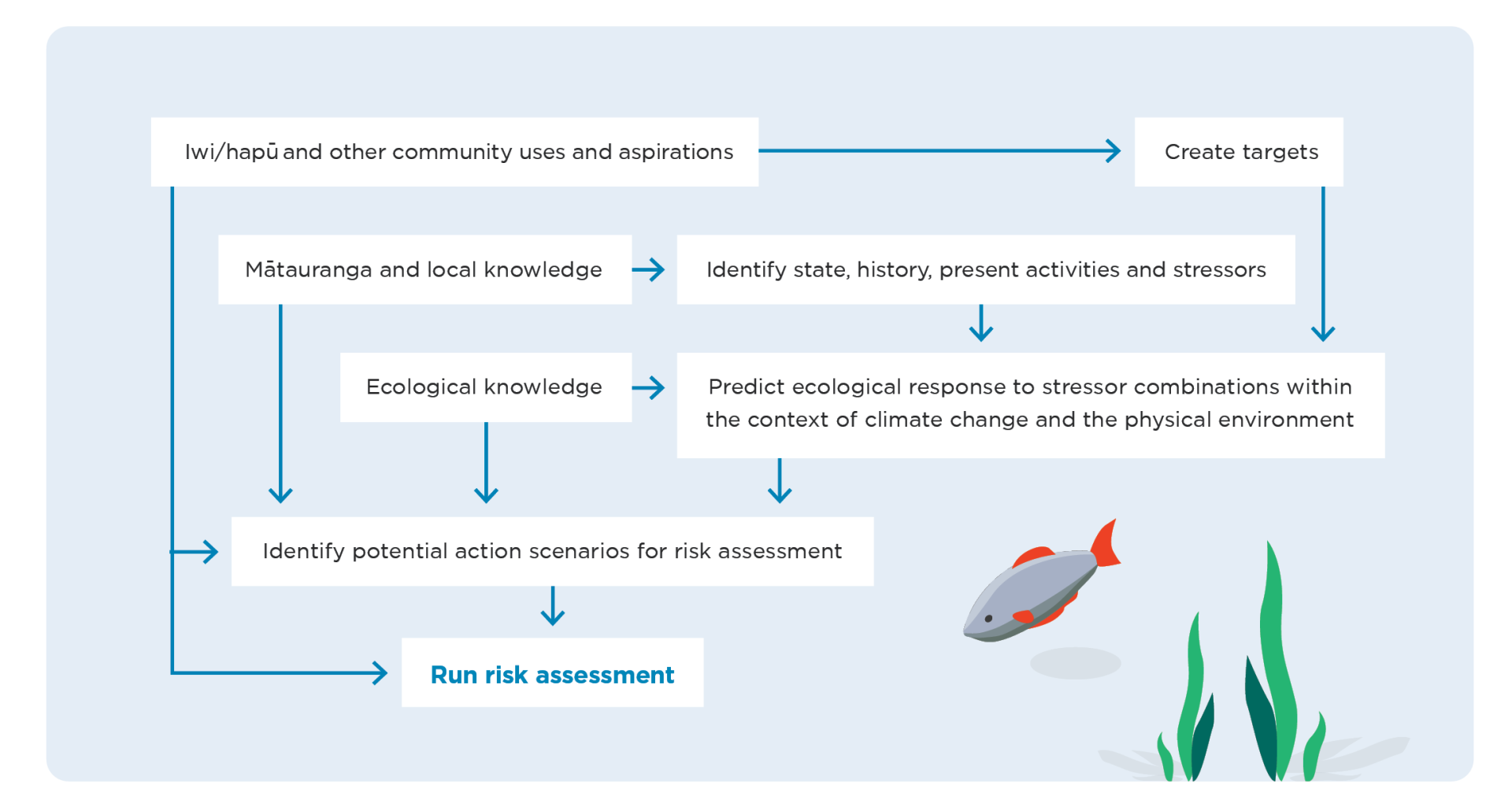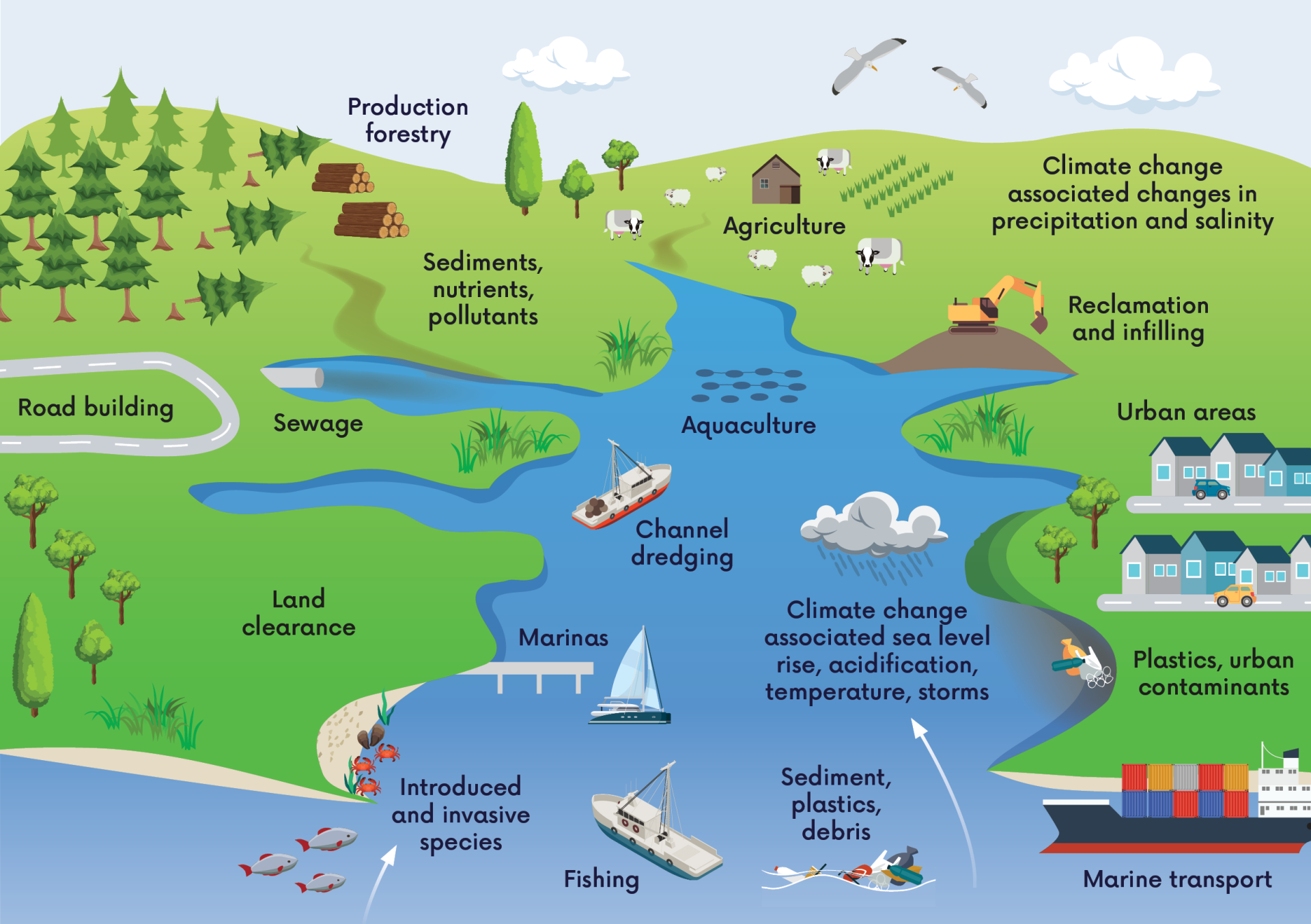- Guidance
Reframing environmental limits for estuaries
This document provides an ecological perspective on how to overcome ecological issues related to the use of national environmental limits. Hewitt J, Bulmer R, Clark D, Couzens G, Ellis J, Gladstone-Gallagher R, Lohrer D, Pilditch D, Thrush S (May 2022)
Estuaries are resilient and can recover with time, but sometimes they need a helping hand.
- Overview
- Protecting estuaries
- Challenges of cumulative effects and multiple stressors
- Challenges of limit-based management
- Management for inter-generational use of estuaries
- National guidance on process, local solutions
Overview
The Government plans to replace the Resource Management Act 1991 (RMA) with a suite of new legislation including the Natural and Built Environments Act (NBA) later this year. The intention of the NBA is "to protect the ecological integrity of the natural environment and human health”.
The NBA is expected to include:
- a mandatory requirement to “set environmental limits for aspects of the natural environment”
- a requirement that “limits will be framed as a minimum acceptable state of an aspect of the environment, or a maximum amount of harm that can be caused to that state”.
These new environmental limits will include limits set for estuaries, which up until now have not been subject to the measurable objective and limit setting approach applied to freshwater bodies through the National Policy Statement for Freshwater Management.
The Government has stated that the purpose of the reform of the RMA is “protecting and restoring the environment and its capacity to provide for the well-being of present and future generations” and the NBA Exposure Draft requires that the national planning framework and all plans must promote the protection, restoration or improvement of the quality of estuaries.
The purpose of the reform of the RMA is “protecting and restoring the environment and its capacity to provide for the well-being of present and future generations”
The emphasis on restoration provides an opportunity to consider ways to manage estuarine ecosystems that move beyond just preventing further degradation through environmental limits and bottom lines and towards setting targets for ecological recovery. Both environmental limits and targets need to be carefully considered for estuaries, however, because estuarine state and responses to stress are highly place and context specific.
In this synthesis we draw on ecological knowledge of estuarine functioning to propose a tailored approach to estuary (and environmental) management based on national level best practice processes and guidelines aligned and integrated with local knowledge and actions.
We draw on ecological knowledge of estuarine functioning to propose a tailored approach to estuary (and environmental) management.
Our approach is consistent with the views expressed by various hapū, iwi and Māori on the NBA exposure draft noting the importance of iwi and hapū using mātauranga Māori to develop and deliver solutions tailored to place and context. While these submissions highlight that limits are not flexible enough to deal with local applications, this perspective points out ecological problems with a general use of national limits for estuaries.
We have not attempted to articulate a Te Ao Māori world view in this discussion paper, as this is more correctly for hapū and iwi to do. Rather we are aware through our hapū and iwi-led research that there are likely to be overlaps in the solutions.
We use the term 'estuaries' throughout to encompass estuaries, harbours, sounds and fiords.
Protecting estuaries
Estuaries are wonderful ecosystems. They are highly productive and provide numerous ecosystem services, for example:
- Improving water quality
- Supporting fisheries
- Protecting our coastline
The diversity of habitats contained within estuaries (eg, crab burrows, seagrass meadows, worm mats, shellfish beds) support a wide array of species that are critical for ecosystem functioning and integrity. Estuaries with greater habitat and species diversity are likely more resilient to human activities because they offer ecological redundancy and more pathways for recovery.
Unfortunately, the people who live around and use estuaries have seen them change and their uses diminish. The Our Marine Environment 2019 report clearly outlines the continuing degradation of the marine environment, particularly estuaries.
Environmental management on land has taken a restorative lens for decades. Increasingly there is a similar desire from communities living on our coasts, as evidenced by marae, iwi and harbour care groups, to focus on managing to recovery rather than just halting decline.
Increasingly there is a similar desire from communities living on our coasts, as evidenced by marae, iwi and harbour care groups, to focus on managing to recovery rather than just halting decline.
Challenges of cumulative effects and multiple stressors
Estuaries, located at the interface between the land and the sea, are subjected to marine and terrestrial derived stressors. They are at the forefront of climate change impacts. Activities that occur within the estuary (eg, marinas, aquaculture) also generate stress on the ecosystem.
Figure 1: Stressors affecting estuaries (adapted from biome-estuaries.weebly.com/threats-to-estuaries)
As one of our most multi-use ecosystems, estuaries are subject to cumulative effects and multiple stressors.
Multiple stressors concern us because of synergism ie where the combined impacts can be larger than individual ones, creating ecological surprises or tipping points (which usually result in a loss of ecosystem functions and services).
Multiple stressors concern us because of synergism ie where the combined impacts can be larger than individual ones, creating ecological surprises or tipping points
Research internationally and within NZ has demonstrated that it is the slowly accumulating ecological responses to stressors that are often at the heart of the ecosystem tipping points and the thresholds that cause 'surprises'. When this happens, the ecological responses can lag behind the cause and often are not visible until after crossing a threshold (or just before when it is too late to act).
The ecological responses can lag behind the cause and often are not visible until after crossing a threshold (or just before when it is too late to act)
While there is evidence of ecosystem responses to specific stressors (sometimes in combination) that can be generalised, research also demonstrates the importance of place and history in how an estuary will respond.
For example, over the years we have moved from thinking that 15% mud content represents a threshold beyond which negative ecological effects will occur, to realising that there is another earlier threshold at 3-5% mud. As this earlier threshold is passed, estuaries become less able to remove bio-available nitrogen, making them more vulnerable to the effects of nutrient loading.
We now think of estuaries as undergoing a cascade of tipping points, driven by cumulative effects.
Knowing where the estuary is placed within the cascade (history) and which stressors now are drivers (place) is key to management.
Knowing where the estuary is placed within the cascade (history) and which stressors now are drivers (place) is key to management.
Challenges of limit-based management
The use of “minimum acceptable state (MAS)” or a “maximum amount of harm that can be caused (MAH)”, are targeted at ecological integrity of which we have no robust measures for estuaries.
The use of MAS or MAH are targeted at ecological integrity of which we have no robust measures for estuaries.
We do have indices based on how sediment dwelling animals respond to changes in mud, urban metal contaminants and phosphorus that can be consistently applied nationwide. However these indices do not capture other important aspects of estuarine ecological integrity including ecological functioning, diversity at the habitat scale or the degree to which human uses, values and aspirations are supported.
These aspects cannot be represented by a set of easily measured/modelled, annually averaged physical-chemical parameters. Instead, a national set of highly place-based ecological parameters would need to be developed, a complicated, time consuming and costly process.
A national set of highly place-based ecological parameters would need to be developed, a complicated, time consuming and costly process.
Estuaries are highly susceptible to climate change effects, such as sea level rise, changes in temperature, storms, and productivity. Any limits set now on “maximum amount of harm”, stressors or activities may not be applicable in 10 or 20 or 30 years. Even limits set on “minimum acceptable state” may have to be reviewed as heatwaves or temperature controls on species distributions, alter possible states.
Any limits set now on “maximum amount of harm”, stressors or activities may not be applicable in 10 or 20 or 30 years.
To date for freshwater management “acceptable state” has been proposed to be achieved by setting “limits for single stressors”, that may then be translated into “limits on activities” that generate the stressors. The potential for tipping points and synergistic responses in estuaries, and the high value of these ecosystems, require processes that promote management of multiple stressors rather than actions that seek to limit single stressors.
Using the terms ‘acceptable state’ and ‘harm’ in the NBA also highlights the difficulties and risks in focusing merely on preventing degradation.
The potential for tipping points and synergistic responses in estuaries, and the high value of these ecosystems, require processes that promote management of multiple stressors rather than actions that seek to limit single stressors.
Using the terms ‘acceptable state’ and ‘harm’ in the NBA also highlights the difficulties and risks in focusing merely on preventing degradation.
Figure 2: Knowledge requirements and advantages of setting local recovery targets in comparison with national limits for estuaries (click to expand) 
Management for inter-generational use of estuaries
Setting bottom lines has numerous risks and requires considerable data to be effective in a multi-stressor environment where legacies are likely to occur.
If limits were only set at a national level they would have to be very conservative to avoid unexpected degradation of estuaries. This is due to:
- the complexity of estuaries' ecosystems
- locational differences between place and history
- the need to apply the precautionary principal due to the lack of long-term data and the knowledge of responses to many stressors
We need to think carefully about how to manage estuaries in a way that is not overly complicated, expensive or data hungry, so that the necessary translation of policy into restorative actions is not stifled, and so that management can be adaptive and agile over time.
We can achieve local recovery goals using nuanced risk assessments, that incorporate mātauranga and other local knowledge, alongside what ecologists already know more generally about how ecosystems work, respond to stress, and recover. Such a process will provide for local activities, targets and actions.
We can achieve local recovery goals using nuanced risk assessments
Figure 3: Example of a risk assessment process 
Policy alone is not enough. To achieve increases in estuarine integrity, resource managers and communities need to be empowered to make adaptive/flexible decisions. National guidance on the risk assessment framework, and the types of data/knowledge needed, would be useful.
Resource managers and communities need to be empowered to make adaptive/flexible decisions.
It is important to recognise that management actions taken today may not be met with concomitant ecosystem responses for decades to come. As the Parliamentary Commissioner for the Environment Managing our Estuaries states, stressors “combine to form a cocktail whose consequences can persist long after their use has ceased”.
National guidance on process, local solutions
We suggest that managing the marine environment (particularly estuaries) should include:
-
Reversing the intent from limits intended to prevent further degradation to setting targets for ecological recovery
-
Establishing a process for setting environmental targets for ecological integrity in the presence of multiple/ accumulating stressors, including the setting of long-term goals for each estuary by regional (or local) resource managers in partnership with iwi/hapū and local partners.
- Developing national level best practice-guidelines for a nuanced risk assessment that can be used to identify the most likely mix of stressors driving degradation and recovery of target outcomes in any specific estuary, considering climate change. These guidelines could be built from a series of small case studies in a variety of estuaries.
- Supporting research into national metrics. Metrics that capture ecological responses to cumulative effects and natural spatial variation of habitats within estuaries while supporting local tohu and aspirations would be transformative.
- Setting national timescales for assessment of targets and making provisions for funding the monitoring of national ecological metrics and progress to regional targets.
- Establishing a process for effective collaboration between iwi/hapu and agencies who have priorities in different areas, such that possible changes that could impact on goals set for estuaries could be discussed. Partnership and collaboration between iwi/hapu, regional councils and fisheries managers is particularly important considering customary and recreational take and the potential for changes in fish species that use both estuaries and ocean areas to impact on estuary dynamics.
Given the multi-use nature and complexity of processes in estuaries, we anticipate these components would also be valuable for terrestrial, freshwater, and fully marine systems.
